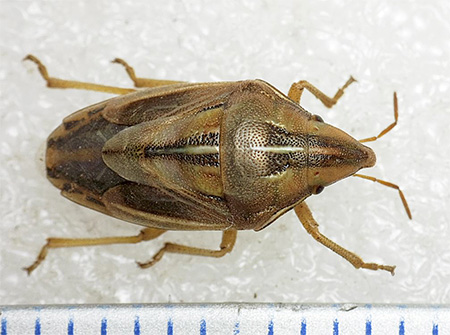
The squad of Hemiptera, which people are accustomed to calling bedbugs, is very numerous and diverse. Different types of bugs known to entomologists today sometimes differ so much from each other in appearance, food preferences and lifestyle that a non-specialist is unlikely to consider them relatives.
You can meet bedbugs everywhere: in fields and flower beds, on land and in the sea, some families have settled in the tropics, others have learned to endure the harsh Siberian winters. Some prefer plant foods, others prey on their own kind, and still others are real bloodsuckers.
There are also varieties of bedbugs that are too strongly attached to people. They appreciate the comfort of human buildings and smell the warmth of their prey from a mile away. Together with their food source, bedbugs are able to travel the world, so they can even end up in the Arctic.
Let's take a closer look at the different types and varieties of bedbugs, and also see how they look in the photo.
Farmland pests
Oh, how gardeners and gardeners do not like bedbugs. After all, many of them destroy the landings, so reverently protected by man.
Every housewife knows by sight the destroyers of her own crops. It can often be found on the beds of the Cabbage bug. He is visible from afar in his red and black outfit, it is not without reason that he is called decorated (see photo):

Its partner, the Rape Bug, has a gleaming blue-green back with spots and stripes of white or red (however, its color is changeable):
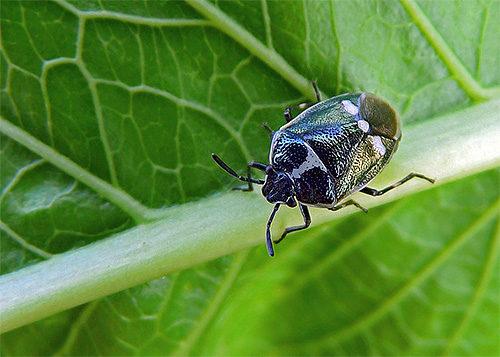
Bright, defiant coloration is characteristic of many types of bedbugs. It serves as a kind of protection against natural enemies, they say, that's how scary I am.
In case of danger, bugs can use another argument - an unpleasant smell. Special glands found in most Hemiptera produce a substance called cimicic acid. It is she who provides the bugs with an aroma, because of which people do not like them very much, and the birds do not tend to peck them.
These insects are not without reason combined into one group of cruciferous bugs, because it is plants from the family with the same name that are most often invaded by such pests - radish and turnip, rapeseed and cabbage. Adults and larvae feed on plant sap, damaging its delicate skin. Yellowish spots remain on the leaves - traces of the meal of insects. Weak seedlings after such injuries may die.
Light green shield bug (Palomena Prasina). This variety of bugs can be recognized by its greenish-yellow color, oval shape, slightly narrowed backwards and characteristic protrusions on both sides of the body. They serve as a sign that the bug belongs to the family of stink bugs. By autumn, the color of the insect miraculously changes to brown. It can be found in the garden, it feeds on raspberry and gooseberry juices, but does not disdain cereal crops. This bug can spoil the impression for children who decide to eat a berry. Below are his photos:
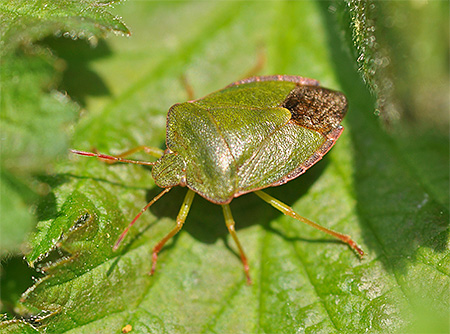
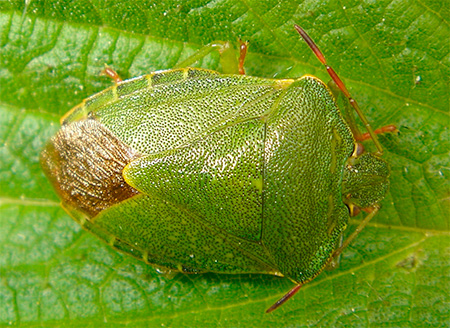
The harmful turtle bug (Eurygaster integriceps) is a gray nondescript creature, as you can see by looking at the photo of this type of bug:

After overwintering in the fallen leaves, the starving insects furiously draw juices from the young shoots of cereal crops, and the larvae emerge from the eggs by the time the ear fills up and damages it. The grains become unsuitable for making flour and lose their germination capacity.
Turtles, together with the Bread bug from the Horsefly family and bugs of other species, devastated more than one grain field. It is unlikely that someone will burn with love for such living creatures. So the owners of the estates transfer their hatred to all other varieties of bedbugs, even completely innocent ones.
And further: The Get Express tool really killed all the bugs quickly - after 42 minutes only corpses were lying around
But it turns out that a disgusting smell does not always help bedbugs to avoid retribution.Each chicken released to walk around the field is capable of destroying up to one and a half thousand harmful turtles per day.
harmless bugs
The war paint of some types of bedbugs fulfills its purpose - they are treated with caution. Take a look at the photo below. This is the Line Bug (Graphosoma lineatum), sometimes it is called Italian, either in honor of the area where it was first discovered, or for its resemblance to the form of the guards of the Pope:

Having met such a handsome man in his garden, many would be seriously scared, mistaking him for a Colorado potato beetle that has undergone a mutation. But in fact, minke whales cannot bring much harm to the garden and garden; they prefer umbrella plants.
Even in the years of their mass reproduction, it is quite easy to deal with them - it is enough to collect them by hand. These bugs usually spend the mating period gathering in a company, so it's easier for them to find a soul mate.
And who has not seen how whole groups of soldiers accumulate on stumps or under tree roots? The scientific name of this species of bed bugs is the wingless red bug (Pyrrhocoris apterus). And their photos are below:
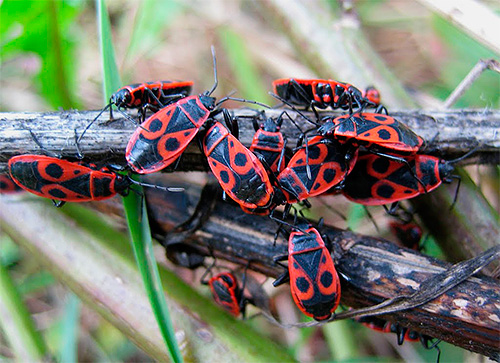
These insects, familiar from childhood, are quite widespread, feeding on fallen seeds and the remains of dead invertebrates.
The alder hen bug (Elasmucha fieber) is a typical representative of the tree bug family. Having recovered from hibernation, by the beginning of summer this unusual variety of bedbugs enters the breeding season:

Alder bug females firmly settle on the leaves of alder, currant or birch. There they spend quite a lot of time, first protecting the laid eggs, then nursing the hatched larvae.The bug does not leave its offspring until the kids become active enough and leave their native nest themselves.
Bed bugs - conquerors of the water element
On the water surface of ponds or lakes, you can see a slender and nimble insect with a thin body on high, widely spaced legs:
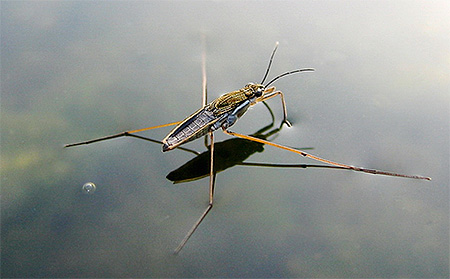
Oddly enough, this is a representative of the Hemiptera family - the common water strider (Gerris lacustris). Some invisible force keeps her on the surface of the water.
Her paws are abundantly covered with small hairs, they never become wet, thanks to the grease that covers the hairs. The bug quickly glides through the water and sucks the juice from gaping insects that have fallen into the water. For the winter, water striders, limping, leave the reservoir and find refuge in the fallen leaves.
No less interesting is another species of bugs living in the aquatic environment - the Water Scorpion (Nepa cinerea):
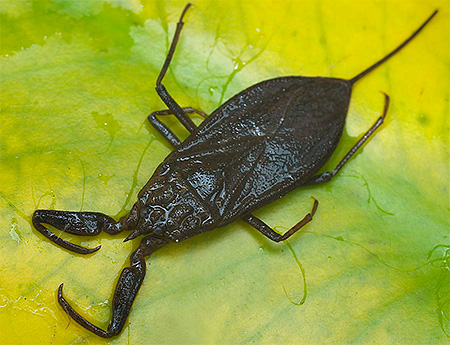
Its appearance fully justifies the name. The front paws, more like claws, serve to capture the victim, and behind there is a long outgrowth, similar to a needle. The bug lives in shallow water, because it does not know how to swim at all, hides in algae, crawls along the bottom in anticipation of the victim, exposing its tail process above the water, it serves as a breathing device for it.
Among the bugs there are real swimmers. The photo shows one of them:
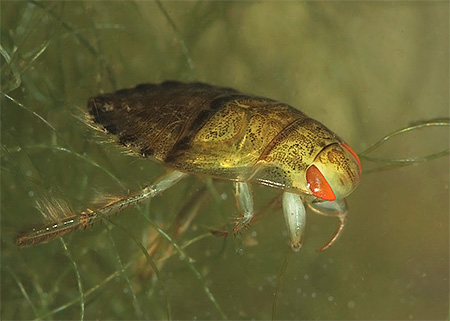
This is Plautus vulgaris (Hiocoris cimicoides). He has a dark green with an olive tint powerful body, paws, shaped like oars and densely covered with hairs. This type of bedbug preys on insect larvae, fry and molluscs and spends almost all day doing this activity.
Bed bugs are parasites
Unfortunately, there are species in the order of Bedbugs that are very unpleasant for humans. They live by sucking blood from humans and warm-blooded animals. As soon as the insect shown in the photo is not called:
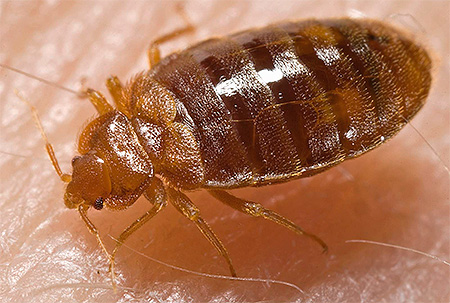
Bed bug, he is home or linen. Biologists classify it as Cimex lectularius. A flat, wingless creature with a keen sense of smell, capable of changing size and color by saturating itself with blood. In general, the family has more than 70 types of bed bugs.
Its closest relative is the Burning Bug, or Cimex Hemipterus:

Outwardly, it differs very little from its fellow, but a number of features nevertheless allowed scientists to distinguish it into a separate species. It moves more slowly, bouncing slightly, does not endure the cold, and therefore is distributed exclusively in countries with a hot climate; if accidentally imported to northern latitudes, it does not survive there for a long time.
The bites of a burning bug are more noticeable: this is a pronounced allergic reaction like urticaria, severe itching, blisters often appear, reaching 5 cm.
But the most dangerous representative of the Hemiptera squad lives in Latin America:
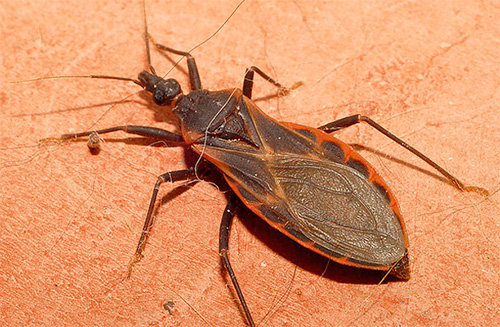
Triatomine bugs from the family of predators are nocturnal and often attack sleeping people. Their bite provokes an allergic reaction of varying severity: from slight irritation up to anaphylactic shock.
But this is not all the evil he is capable of. Insects are carriers of a deadly disease caused by protozoa - trypanosomiasis, otherwise Chagas disease. For this, the bites of Triatam bugs were nicknamed deadly kisses.
And the bug can be useful
A person is used to thinking rationally and evaluating the surrounding fauna, based on the benefits that it brings to him.Farmland pests and ectoparasites are perceived as aggressors, and a ruthless struggle is waged against them. But often help comes from the side where you least expect it.
Potatoes are considered the second bread. What tricks do people go to to save the cherished root crops from the Colorado potato beetle. But they have allies in this fight.
Zikrona blue, a species of predatory bugs native to England. A bluish-green insect with a metallic sheen, capable of hunting only in the daytime due to the fact that it simply cannot see at night. Zikrona eats eggs or small larvae of leaf beetles.
Another wrestler belongs to the genus Perillus - Perillus bioculatus .:

It is noticed that he manages to cope even with adults. So far, bedbugs cannot compete with insecticides, but scientists are actively exploring the possibility of using entomophages in the battle to save crops.
The fauna of tropical countries is interesting and unusual for a Russian look. There are special varieties of bedbugs that amaze with their sizes, shapes and colors. Here is such an unusual creature, captured in the photo, you can admire in the forests of South America:
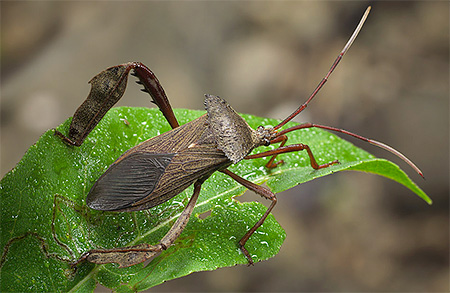
The leaf-legged bug, belonging to the Kraevikov family, has unusual extensions on its hind legs, similar to leaves.
The world of insects is huge, their life, subject to strange instincts and full of miraculous transformations, is of genuine interest. Few people know what beautiful types of bedbugs are found on our planet. People are used to thinking badly about this detachment, but there are truly unique specimens in it that can please the eye and surprise.






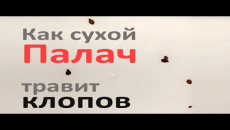
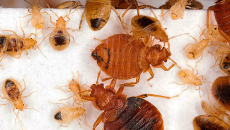
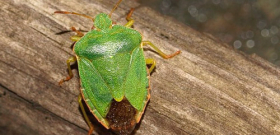


I watched viburnum and its pest: "Viburnum leaf beetle." There are useful bugs that quickly destroy them, one shell remains from the bug within one to two minutes.